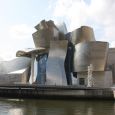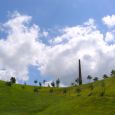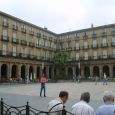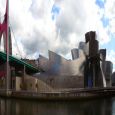Bilbao
Advertisement
By plane
Bilbao Airport (IATA: BIO) is served by Lufthansa, Spanair, Air France, Air Berlin, TuiFly, AerLingus, Iberia, Air Europa, Vueling and several other airlines. Easy Jet flies from London Stansted to Bilbao airport. You can also fly with Ryanair to Santander.
To get to downtown from the airport, take Bizkaibus from the arrivals sidewalk: there is no arrivals hall. The bus leaves every half hour at :15 and :45 past the hour from the airport to Bilbao bus terminal. The reverse journey is at :25 and :55 past the hour from the bus terminal to the airport, stopping at Plaza Moyua on the way. A single ticket costs less than €2.
By bus
All buses to other provinces leave from the TermiBus terminal. There are regular connections to Santander (75 minutes) San Sebastian (60 minutes) and Madrid (arriving at Avenida de Las Americas bus station, 4-5 hours) among others.
The bus companies connect Bilbao with many cities in Spain more cheaply and frequently than the rail companies.
By train
RENFE-- runs intercity trains to Madrid, Barcelona, Vigo (Galicia). All Renfe trains leave from Abando Station.
FEVE -- runs regional trains to Santander (3 daily), and Leon (1 Daily). They are very slow, and make a stop in almost every single town they pass through. From Santander you can continue to Oviedo (Asturias), and La Coruña (Galicia). This journey has three legs, but it is only possible to do 2 legs in any one day. FEVE trains leave from Santander Station (next to Abando Station)
By boat
A direct car ferry is available between Bilbao and Portsmouth, England. It is best to book early, since the ferry is often booked out in summer. By taking the P&O ferry[4] to Bilbao and immediately returning, a mini-cruise can be had which allows approximately two and a half hours in Bilbao.
Guggenheim Museum
Frank Gehry's spectacular twisting titanium-clad modern art museum is perhaps the most celebrated building of the 1990s. The graceful, sensuous curves, evocative of the ships that used to be ubiquitous along the docks of Bilbao, are covered in titanium squares, which resemble the scales of a fish and shimmer in the sunlight. In keeping with the maritime theme, appropriate for the setting, the skylights of the largest gallery (formerly known as the Fish gallery) are designed to look like the fins of fish. Many parts of the building are purely decorative, and don't serve any purpose. The permanent collection is not particularly impressive, but the museum always hosts at least one interesting temporary exhibit, frequently comprised of masterpieces from the other Guggenheim collections. Adults €13.00; students under 26: €7.50; children under 12: free
Museo de Bellas Artes
The Museum of Fine Art's remarkable collection currently boasts more than six thousand works dating from the 12th century to the present day, and includes paintings, sculptures, drawings, engravings and decorative objects. General: €6.00; groups, students, senior citizens and unemployed: €4.50. Free of charge on Wed, and for children under 12. Artean Package, €13.50 (tickets for both the Guggenheim Museum and the Fine Arts Museum). Prices change for special exhibition
Cathedral of St. James
Cathedral of St. James Gothic Style 14th century Cathedral, named after Bilbao's official patron saint. Three naves and small Gothic cloisters. The building was designated a cathedral in 1949. Its Neogothic tower and main façade were designed by Severino de Achúcarro in the 1800s. The adjoining square (Plaza de Santiago) bosts a fountain designed by Luis Paret during the reign of Carlos III with the inscription Por el bien público (For the good of the people).
Basilica de Begona
Overlooking Bilbao, this is perhaps the most symbolic religious building in the city. Built in the 16th Century by Sancho Martinez de Arego, who was also responsible for the Iglesia San Anton. It is a basilica of three naves. During the first Carlista War, in 1835, the façade and the tower were destroyed. The present ones were designed Jose Maria Basterra and constructed between 1902 and 1907.
Plaza Nueva
Plaza Nueva Bilbao's Plaza Nueva was originally named Plaza de Fernando VII. Construction began on the plaza on December 31, 1829 and finished exactly 20 years later on December 31, 1849. This plaza was the seat of the Diputación de Vizcaya until July 1900 when the Diputación moved to its new home on the Gran Vía. The Academy of the Basque Language (Euskaltzaindia) currently occupies the old Diputación building in the Plaza Nueva. There is a market of used books, stamps, coins, and other small items in the plaza every Sunday morning. The Plaza Nueva is surrounded by buildings and only has entrances on some sides.
Information not available





